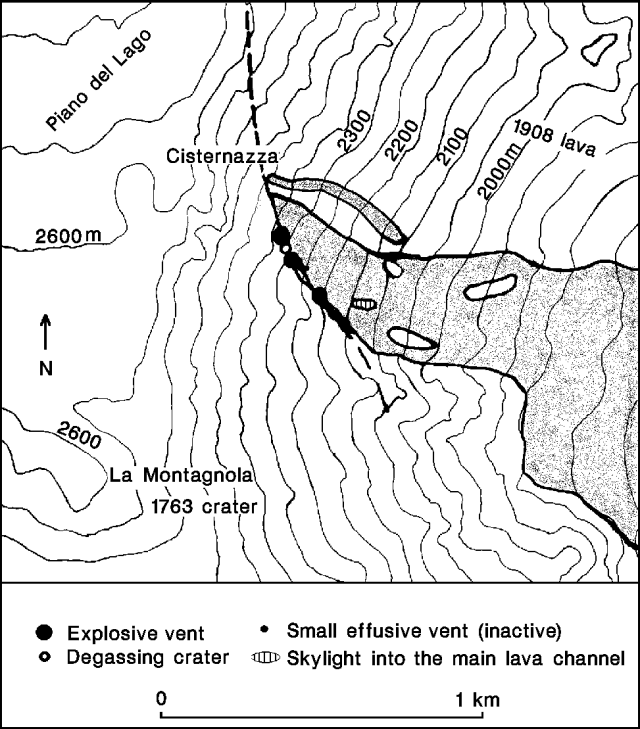Report on Etna (Italy) — June 1992
Bulletin of the Global Volcanism Network, vol. 17, no. 6 (June 1992)
Managing Editor: Lindsay McClelland.
Etna (Italy) Continued flank lava production
Please cite this report as:
Global Volcanism Program, 1992. Report on Etna (Italy) (McClelland, L., ed.). Bulletin of the Global Volcanism Network, 17:6. Smithsonian Institution. https://doi.org/10.5479/si.GVP.BGVN199206-211060
Etna
Italy
37.748°N, 14.999°E; summit elev. 3357 m
All times are local (unless otherwise noted)
Lava production continued from the fissure that opened in the W wall of the Valle del Bove on 15 December. Gas emission from 4 vents in the upper part of the fissure (2,215-2,235 m altitude; figure 52) fluctuated daily, probably with changes in weather conditions. However, gas emission has diminished since the eruption's initial months.
 |
Figure 52. Sketch map of the fissure system and the upper part of the lava field at Etna, June 1992. Contour interval, 50 m. Courtesy of Romolo Romano. |
No variation was evident in the movement of lava visible through a skylight high in the main channel, at 2,205 m altitude. Lava was also seen flowing through a skylight in lava tubes that formed in June along the channel into which lava was artificially diverted on 27 May (~ 1,980 m elevation) (17:05). From there, lava advanced through a complex series of tubes past the field that had formed in recent months. Lava again reached the surface around 1,800 m altitude from a changing number (generally 3-4) of ephemeral vents at varying locations representing tube bases. Lava flows extruded from these vents have generally been modest, have remained in the center of the lava field, and have not advanced beyond 1,600 m asl. As of the morning of 9 July, only one flow was active within the Valle del Bove, near the center at around 1,670 m altitude, with a fairly well-fed front. The volume of lava produced during ~7 months of eruption is estimated to be around 165 x 106 m3.
Seismic activity during the period was characterized by low energy release. Significant increases were observed 8-9 July, when events of 2-4 Hz were recorded. The most significant perturbations were detected on 8 July at 1554, for 180 seconds, and at 1601 for 130 seconds. Tremor was almost nonexistent, obscured by seismic noise that characterizes periods of low activity at the volcano.
More or less voluminous gas emissions occurred from two vents at the bottom (~100 m from the rim) of the two central craters (Bocca Nuova and La Voragine). Incandescence caused by superheated gases (>1,000°C) from the vent in La Voragine was sometimes visible. Gas also emerged from a vent that has opened in Southeast Crater. Northeast Crater appeared to have been completely obstructed by internal collapse. COSPEC measurements of SO2 flux from the summit crater showed relatively high values of ~ 8,000 t/d.
Geological Summary. Mount Etna, towering above Catania on the island of Sicily, has one of the world's longest documented records of volcanism, dating back to 1500 BCE. Historical lava flows of basaltic composition cover much of the surface of this massive volcano, whose edifice is the highest and most voluminous in Italy. The Mongibello stratovolcano, truncated by several small calderas, was constructed during the late Pleistocene and Holocene over an older shield volcano. The most prominent morphological feature of Etna is the Valle del Bove, a 5 x 10 km caldera open to the east. Two styles of eruptive activity typically occur, sometimes simultaneously. Persistent explosive eruptions, sometimes with minor lava emissions, take place from one or more summit craters. Flank vents, typically with higher effusion rates, are less frequently active and originate from fissures that open progressively downward from near the summit (usually accompanied by Strombolian eruptions at the upper end). Cinder cones are commonly constructed over the vents of lower-flank lava flows. Lava flows extend to the foot of the volcano on all sides and have reached the sea over a broad area on the SE flank.
Information Contacts: R. Romano and T. Caltabiano, IIV; P. Carveni, M. Grasso, and C. Monaco, Univ di Catania; G. Luongo, OV.

